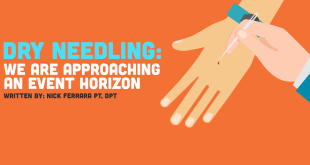If you asked me three years ago to define mindfulness, I’d have probably responded, “It’s the inner calm I feel during yoga.”
And I wouldn’t have the first clue how to introduce mindfulness into my career as a physical therapist. As a recent graduate, you have this extensive toolbox of skills and knowledge and think, “I can fix patients!”
Oh! And this is all occurring while trying to balance your personal life, impending student loans, etc.
In short, it’s easy to let all of this negative stress affect your life and your career.
So how does mindfulness come in handy? Mindfulness is more than the practice of meditation; it is a state of awareness to yourself and your surroundings that can lead to personal and professional growth. Mindfulness can be another vital tool in your toolbox. In this article, you will understand the (1) definition of mindfulness, (2) how to introduce self-mindfulness, and (3) strategies to implement mindfulness into your plan of care with patients.
What is mindfulness?
Dr. Ronald Epstein, author of Attending and Mindful Practice, defines mindfulness as “a purposeful, non-anxious, reflective presence that can be applied to any aspect of practice.”1 The descriptive word “purposeful” means acting with intention. It is important not to be anxious with mindfulness; you must ignore any preconceived myths that only the Dalai Lama and yogis can practice mindfulness. Reflection is a word that calls for assessment and evaluation (sounds familiar, right?) of an action or thought.
Guide to self-mindfulness
Practicing mindfulness is like teaching a patient about good posture.
During physical therapy, the patient may demonstrate good cervical and scapular retraction; however, that patient’s attention to their posture dissolves as soon as they leave the room. Mindfulness is similar to posture education: it’s useless unless the person can apply this skill to everyday life.
Bring awareness to brushing your teeth. Bring undivided attention to walking your dog. Slow down and take note how each phase of the gait cycle feels. (Hint: our skills for gait analysis can transfer to the skill of walking meditation.)
What did you feel at work today? Did you take time to consider all the possibilities for a patient’s treatment plan? Or did you choose your “go-to” exercises? Mindfulness and reflection are complementary, and can prevent clinicians from developing bad habits.
Keep in mind that there’s a difference between the ability and the willingness to reflect on oneself. Schedule a time once a month where you perform your own chart review on a random patient. Study and assess your clinical decision making skills. Ask yourself, “Why did I choose that treatment over another?” and “How could I have made that treatment session even better?”
Being a reflective practitioner can encourage mindfulness and critical thinking, and it can help prevent burnout.
In 2009, Krasner et al studied the effects of an 8-week intensive continuing education course in mindfulness, self-awareness exercises, narratives about meaningful clinical experiences, etc. with a 10-month maintenance phase for primary care physicians in Rochester, NY. Results indicated improvements in mindfulness, burnout, empathy, total mood disturbance, and emotional stability.2
Various resources on mindfulness and meditation provide helpful tools to “reboot” our presence, such as drawing attention to your jaw or looking outside at the clouds. Simple tools, like the ones mentioned above, can help prevent signs and symptoms of burnout.
Lastly, be purposeful with conversations among colleagues. We all have become victim to run of the mill, automated conversation on Monday mornings. “How was your weekend?” [Good. How was yours?] “Good.” Instead, try and remember specific details about them and have individualized conversations.
For example, ask your physical therapist assistant, “How was your kimchi making class last weekend?” It seems simple, but you can develop a positive work environment by taking the extra time to share and develop organizational mindfulness with colleagues. Vogus and Sutcliffe studied the impact of safety organizing, trusted leadership, and care pathways on reported medication errors in hospital nursing units.3
Strategies for mindfulness with patients
It can be as simple as having a mindful conversation with a patient. Your attention and body language are directed at the patient and not at your COW (computer on wheels). It’s your opportunity to develop trust with your patient and express empathy.
There is significant research in the effects of mindfulness in the chronic pain population. It’s a population I think most clinicians shy away from because the patients’ symptoms are chronic and they’ve probably tried PT multiple times without success.
Please don’t shy away.
Butler and Moseley, co-authors of Explain Pain, provide information presented in plain english for both clinicians and patients. It explains the physiology of pain, how pain is interpreted in the brain, how pain is individually experienced, how pain beliefs and behaviors can affect outcomes, and tips for pain management.4 Dr. Kabat-Zinn studied the effect of a 10-week stress reduction and relaxation program on 51 patients with chronic pain. Results indicated 65% of the participants reported 33% or greater reduction in pain rating and 50% of the participants showed a reduction of 50% or greater on a pain rating scale.5 An additional study by Dr. Kabat-Zinn reported after the same 10-week program and at 15-month follow up, participants reported decreased pain-related drug use and increased self-esteem and activity level.6
This article is my outlet for what I’ve learned from mindfulness thus far and my attempt to cultivate a mindful profession of physical therapists.

Private Practice Owners Read This.
If you have job opportunities that’s great for new graduates, our community of new grads would love to know about them! Call me anytime at 858-246-7066 and I will personally help you find the right PT for your opportunity.
References:
Epstein R. Mindful practice in action (I): technical competence, evidence-based medicine, and relationship-centered care. Families, Systems & Health. 2003; 21(1): 1-9.
Krasner et al. Association of an educational program in mindful communication with burnout, empathy, and attitudes among primary care physicians. JAMA. 2009; 302(12): 1284-93.
Vogus T and Sutcliffe K. The impact of safety organizing, trusted leadership, and care pathways on reported medication errors in hospital nursing units. Medical Care. 2007; 45(10): 997-1002.
Butler D & Moseley L. Explain Pain, 2nd Edition.
Kabat-Zinn J. An outpatient program in behavioral medicine for chronic pain patients based on the practice of mindfulness meditation: theoretical considerations and preliminary results. General Hospital Psychiatry. 1982; 4: 33-47.
Kabat-Zinn J, Lipworth L, Burney R. The clinical use of mindfulness meditation for the self-regulation of chronic pain. J Behav Med. 1985; 8(2): 163-90.
 NewGradPhysicalTherapy.com The Largest Online Resource For New Grad Physical Therapists
NewGradPhysicalTherapy.com The Largest Online Resource For New Grad Physical Therapists






